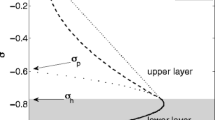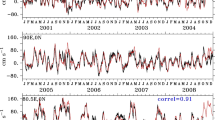Abstract
Some features of tidal current ellipses near the ocean floor are estimated from the bottom-limit solutions of the tidal equations with constant eddy viscosity. It is verified that a clockwise rotating ellipse becomes broad descending through the bottom boundary, whereas a counterclockwise ellipse becomes narrow except near the critical latitude. The major axis of an ellipse near the floor is directed 45° leftward (rightward) against that of the overlying tidal flow ellipse poleward from the critical latitude in the northern (southern) hemisphere. Equatorward from the critical latitude, the major axis near the floor lines up with that of the overlying tidal current ellipse in both hemispheres. The retrograde rotating hodograph against the overlying clockwise tidal hodograph appears near the floor around the critical latitude. These features are confirmed from the numerical studies using the large eddy simulation model. The deflection of the major axis poleward from the critical latitude is a little smaller, about 19°. Furthermore, the effects of nontraditional Coriolis force resulting from the horizontal component of the earth-rotating vector on the development of turbulence were investigated. When the diurnal tidal current is directed westward, the effective vertical eddy viscosity becomes maximum with developing turbulence. While in the case of a semidiurnal tide, a northward tidal current is preferred for turbulence development.













Similar content being viewed by others
References
Book JW, Martin PJ, Janekovic I, Kuzmic M, Wimbush M (2009) Vertical structure of bottom Ekman tidal flows: observations, theory, and modeling from the northern Adriatic. J Geophys Res 114. doi:10.1029/2008JC004736
Coleman GN, Ferziger JH, Spalart PR (1990) A numerical study of the turbulent Ekman layer. J Fluid Mech 213:313–348
Cushuman-Roisin B, Malačič V (1997) Bottom Ekman pumping with stress-dependent eddy viscosity. J Phys Oceanogr 27:1967–1975
Deardorff JW (1980) Stratocumulus-capped mixed layers derived from a three-dimensional model. Bound Layer Meteorol 18(4):495–527
Defant A (1963) Pysical oceanography. Annales De Geographie 72(390):195–196
Eckart C (1960) Hydrodynamics of oceans and atmosphere. Pergamon Press, New York, p 290
Ekman VW (1905) On the influence of the earth’s rotation on ocean currents. Arch Math Astron Phys. 2:1–52
Fjeldstad JE (1929) Contribution to the dynamics of free progressive tidal waves. Geofysisk Institutt, Bergen, p 80
Garcez-Faria AF, Thornton EB, Stanton TP, Soares CV, Lippmann TC (1998) Vertical profiles of longshore currents and related bed shear stress and bottom roughness. J Geophys Res 103(C2): 3217–3232
Gayen B, Sarkar S, Taylor JR (2010) Large eddy simulation of a stratified boundary layer under an oscillatory current. J Fluid Mech 643. doi:10.1017/S002211200999200X
Gerkema T, Zimmerman JTF, Maas LRM, van Haren H (2008) Geophysical and astrophysical fluid dynamics beyond the traditional approximation. Rev Geophys 46. RG2004. doi:10.1029/2006RG000220
Godin G (1972) The analysis of tides. Liverpool University Press, Liverpool, p 264
Hayashi M, Itoh H (2012) On the importance of the nontraditional Coriolis terms in large-scale motions associated with cumulus convective forcing in the tropic: Forced response problem. J Atmos Sci 69:2699–2716
Hsu C, Lu X, Kwan M (2000) LES and RANS studies of oscillating flows over flat plate. J Eng Mech 126(2):186–193
Hua BL, Moore DM, LeGentil S (1997) Inertial nonlinear equilibration of equatorial flows. J Fluid Mech 331:345–371
Kundu PK, Blanton JO, Janopaul MM (1981) Analysis of current observations on the Georgia Shelf. J Phys Oceanogr 11:1139–1149
Lee J-S, Matsuno T (2007) Intrusion of Kuroshio Water onto the Continental Shelf of the East China Sea. J Oceanogr 63:309–325
Leibovich S, Lele SK (1985) The influence of the horizontal component of Earth’s angular velocity on the instability of the Ekman layer. J Fluid Mech 150:41–87
Li M, Sanford L, Chao S-Y (2005) Effects of time dependence in unstratified tidal boundary layers: results from large eddy simulations. Estuar Coast Mar Sci 62:193–204
Li M, Trowbridge J, Geyer R (2008) Asymmetric tidal mixing due to the horizontal density gradient. J Phys Oceanogr 38:418–434
Li M, Radhakrishnan S, Piomelli U, Geyer WR (2010) Large-eddy simulation of the tidal-cycle variations of an estuarine boundary layer. J Geophys Res 115:C08003. doi:10.1029/2009JC005702
Maas LRM, van Haren JJM (1987) Observations on the vertical structure of tidal and inertial currents in the central North Sea. J Mar Res 45:293–318
McWilliams JC, Huckle E (2006) Ekman layer rectification. J Phys Oceanogr 36:1646–1659
Prandle D (1982) The vertical structure of tidal currents. Geophys Astrophys Fluid Dyn 22:29–49
Raasch S, Schröter M (2001) PALM-A large-eddy simulation model performing on massively parallel computers. Meteor Z 10(5):363–373
Radhakrishnan S, Piomelli U (2008) Large-eddy simulation of oscillating boundary layers: model comparison and validation. J Geophys Res 113:C02022. doi:02010.01029/02007JC004518
Sakamoto K, Akitomo K (2006) Instability of the tidally induced bottom boundary layer in the rotating frame and their mixing effect. Dyn Atmos Oceans 41:191–211
Sakamoto K, Akitomo K (2008) The tidally induced bottom boundary layer in a rotating frame: similarity of turbulence. J Fluid Mech 615:1–25
Sakamoto K, Akitomo K (2009) The tidally induced bottom boundary layer in the rotating frame: development of the turbulent mixed layer under stratification. J Fluid Mech 619:235–259
Simpson JH, Crawford WR, Rippeth TP, Campbell AR (1996) The vertical structure of turbulent dissipation in shelf seas. J Phys Oceanogr 26:1579–1590
Soulsby RL (1983) The bottom boundary layer of shelf seas. Phys Oceanogr Coast Shelf Seas Elsevier Oceanogr Ser 35:189–266
Straneo F, Kawase M, Riser SC (2002) Idealized models of slantwise convection in a baroclinic flow. J Phys Oceanogr 32:558–572
Sverdrup HU (1927) Dynamics of tides on the North Siberian shelf. Results from the Maud Expedition. Geofysiske Publikasjoner, p 75
Thorpe SA, Green JAM, Simpson JH, Osborn TR, Smith WAMN (2008) Boils and turbulence in a weakly stratified shallow tidal sea. J Phys Oceanogr 38:1711–1730
Wakata Y (2010) Numerical simulation of ocean bottom boundary layer. Theor Appl Mech Japan 58:145–151
Wakata Y (2011) Dependence of seafloor boundary layer thickness on the overlying flow direction: a large eddy simulation study. J Oceanogr 67:667–673
Wirth A, Barnier B (2006) Tilted convective plumes in numerical experiments. Ocean Modell. 12:101–111
Wirth A, Barnier B (2008) Mean circulation and structures of tilted ocean deep convection. J Phys Oceanogr 38:803–816
Yoshikawa Y, Endo T, Matsuno T, Wagawa T, Tsutsmi E, Yoshimura H (2010) Turbulent bottom Ekman boundary layer measured over a continental shelf. Geophys Res Lett 37:L15605. doi:10.11029/12010GL044156
Zikanov O, Slinn DN, Dhanak MR (2003) Large-eddy simulations of the wind-induced turbulent Ekman layer. J Fluid Mech 495:343–368
Acknowledgments
Drs. S. Raasch and J. Yoon are appreciated for helping in the use of PALM and for valuable discussions. Drs. Y. Yoshikawa and T. Endo also assisted with helpful discussions. This work was supported by JSPS KAKENHI Grant Number 22340140.
Author information
Authors and Affiliations
Corresponding author
Rights and permissions
About this article
Cite this article
Wakata, Y. Some properties of tidal currents estimated from analytical and LES simulation studies. J Oceanogr 69, 737–751 (2013). https://doi.org/10.1007/s10872-013-0204-6
Received:
Revised:
Accepted:
Published:
Issue Date:
DOI: https://doi.org/10.1007/s10872-013-0204-6




